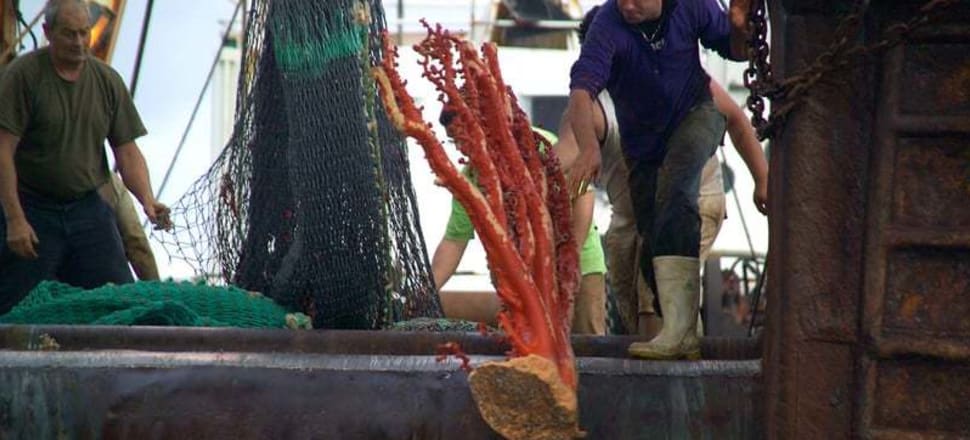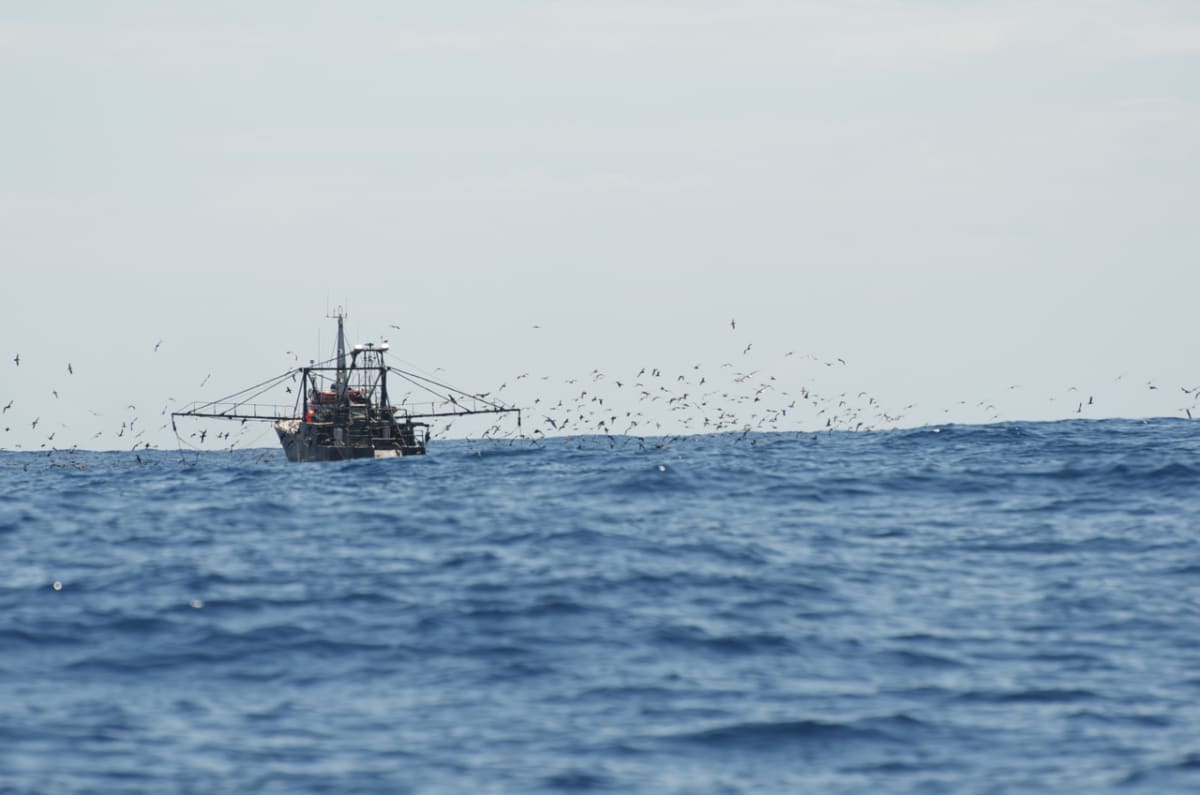
The Government and the fishing industry have left the door open on fishing subsidies and done little on bottom trawling, despite major public outcry.
The message from thousands of submitters to the Fisheries Industry Transformation Plan was clear: stop bottom trawling. But as the final plan was published this week, it was clear the group formulating that plan – a group dominated by fishing companies and the Ministry for Primary Industries (MPI) – wasn't listening.
Greenpeace oceans campaigner Ellie Hooper says the new plan does nothing meaningful to address destruction of the seabed.
“Despite its name there is very little that is transformative about this plan, with no timeline to phase out destructive bottom trawling and an over reliance on mythical ‘techno fixes’ to address the impact commercial fishing has on ocean life.
“We see this plan as a missed opportunity to protect the ocean from the ravages of bottom trawling and truly transform commercial fishing in Aotearoa.”
The draft plan, released in April, was blasted as 'all carrot no stick'.
Not so, says the Government. Announcing the final plan, Minister for Oceans Rachel Brooking said it struck a balance between looking after the ocean and making sure New Zealand had a sustainable seafood sector that can cope with the impacts of climate change.
READ MORE: * Fishing industry plan slammed as nothing but a subsidy * Environmentalists criticise ‘all carrot, no stick’ fishing transformation plan * Fisheries observers miss one in four planned sailings
For example, the transformation plan looks at ways the industry can earn more and create more jobs without catching more fish, by utilising the whole catch in nutraceuticals and other novel uses.
It also suggests the creation, incentivisation and adoption of new technology means restrictions on bottom trawling aren't needed.
Subsidies in or out?
Meanwhile, there are mixed opinions about whether proposals in the plan could leave the door open to fishing industry subsidies.
The draft plan included a point under its 'improving returns and investment across the value chain' subheading that it wanted to confirm government support to assist the transition to new inshore fishing vessels.
The basis of the investment was the current fleet was old, didn’t meet regulatory standards and had a poor carbon footprint with limited financial and business capacity to pay for replacements.
The business case leant on an NZIER report prepared for Northland’s economic development agency Northland Inc, which included a government investment of $46 million or more into a green commercial fishing shipbuilding facility in the region.
In this scenario, the government would also agree to purchase the first three ships and support a transition away from the existing fleet, likely involving a fleet retirement scheme.
Environmentalists and economic think tanks alike identified this as a fishing subsidy.
In a statement to the United Nations Fish Stock Agreement late last year, New Zealand said it did not subsidise its fishing industry and reiterated its stance against subsidies.
Fishing subsidies are a major driver of overfishing globally in allowing for businesses to continue fishing when fish stocks are so depleted the economics no longer stack up.
In theory, once fish stocks are depleted to a certain point revenue will no longer cover cost, sending a message that fish populations need to rebuild.
Subsidies disrupt this and allow the commercial fishing fleet to ignore nature’s signal.
Greenpeace, Legasea and the Deep Sea Conservation Coalition all identified the proposal as a fishing subsidy, as did Eric Crampton of the New Zealand Initiative economic think tank.
Paying people to fish
However, Minister for Oceans Rachel Brooking had previously told Newsroom, rather firmly, that it was not a subsidy, "Paying people to fish would be a subsidy, which New Zealand doesn’t support. What is being proposed here is transitional support for an industry."
Email submissions on the draft plan raised “strong concerns against government funding for the inshore fleet or other environmentally impactful activities.”
This aspect of the proposal has been largely omitted from the final report, but Deep Sea Conservation Coalition campaigner Karli Thomas says the door is still open.
“There’s a tiny bit of walking back, it's gone from saying they’ll identify the government’s support available for it, to they’ll identify whether there’s government support available to it, but the doors are open."
The recommended action for this in the final plan appeared to be the government identifying support available to facilitate the development of a local energy efficient vessel-building industry.
It expects to reach a decision on this within three years.

Companies were supportive of investment in fishing vessels, noting the inshore fleet is aging. Large fishing companies also identified that the deepwater fleet will need renewal and investment in the next 15 to 20 years.
“They’re basically queuing up to get more public money for the incredibly destructive form of fishing that they are reliant on now,” Thomas says.
Quota model
Submissions on the draft plan gave some important context as to why the government might be brought in to fund aspects of construction of a new fleet.
Submitters said there was an insufficient return on investment for the companies actually out catching the fish.
The handful of big companies that own fishing quota in New Zealand typically grant fishing boat operators an annual catch entitlement (ACE) on the proviso they buy the fish caught at a set price, often around $2 a kilogram.
“Some submitters commented on the Quota Management System and identified that costs and regulation fall disproportionately on the ACE fisher, leading to lower returns and lack of investment in the inshore flee,” the report says
The transformation plan also touched on a wider overhaul of the QMS, talking about wanting to “build on what is working” by enhancing it as the foundation for the sustainable management of our fisheries.
Legasea programme lead Sam Woolford says it is a plan to make a plan.
“It fails at the first hurdle because there isn’t actually any talk about restoring our fisheries, rather than some kind of ambiguous environmental statements."
Woolford says currently fisheries were so depressed the only economically viable way to fish was through destructive trawling techniques, which the ITP aims to do more effectively.
“If we had more fish in the water, selective, low impact fishing techniques would immediately become more economically viable.”
Another aspect of the plan Woolford says falls short is around access to quality affordable seafood for New Zealanders.
“There's no desire there to actually prioritise New Zealanders needs, to actually prioritise our ability to get access to good quality protein sources. We live on islands at the bottom of the world, surely that should be something that's tied to an industry transformation.”
Suspiciously similar
Thomas says her initial take on the report was that it looked suspiciously similar to the draft, despite almost 3000 submissions calling for a time bound transition away from bottom trawling.
“It’s pretty misleading to talk about this being developed in collaboration with environmental groups. One person was invited into the process when it was already part way through and two other people got an hour to present.
“That’s not a collaborative process, and our submissions were among those 2700 calling for a ban or end date on bottom trawling and no subsidies. Those have just been counted and ignored.”
Greenpeace's Ellie Hooper says with almost all submitters being against bottom trawling yet it not being addressed, it was clear who was being listened to and who wasn’t.
“The Government has ensured the commercial fishing industry can continue kicking the can down the road, avoiding meaningful changes and continuing ocean destruction. Everyone who wants to see the ocean protected and full of life has been ignored.”
She says there is enough data to act, including a recent report from the Department of Conservation, which found 200 tonnes of coral had been observed being trawled up in the past 13 years, and a recent Fisheries New Zealand review that found sustainability issues in orange roughy populations.
“We know the harm bottom trawling causes and we know what needs to be done to rectify it. We cannot afford more delays in transitioning away from this method, that will only mean more destruction.
“We are in a biodiversity crisis and it’s time to get real about what it’s going to take to reverse that,” Hooper says.
“With the government currently considering bottom trawling restrictions for both seamounts and the Hauraki Gulf, we sincerely hope they will do what‘s right for the ocean, and what the vast majority of people want to see – a ban on bottom trawling.”







